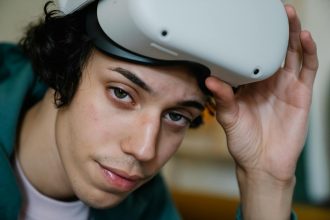Neural Network: Unlocking 7 Key AI Breakthroughs Today
Ever wondered what truly powers the most intelligent systems around us? From recommending your next movie to enabling self-driving cars, the complexity of artificial intelligence often seems daunting, yet at its heart lies a fundamental building block: the neural network. This intricate system is not just a buzzword; it’s a revolutionary paradigm reshaping how machines learn, perceive, and interact with the world.
Unpacking the Power of Neural Networks in Modern AI
A neural network, inspired by the human brain, is a computational model designed to recognize patterns and make decisions. It processes data through interconnected layers of ‘neurons,’ or nodes, each performing a specific calculation. This architecture allows these powerful AI models to learn from vast datasets, identifying complex relationships that traditional programming struggles to uncover.
The Core Architecture: How Neural Networks Learn
At its most basic, a neural network consists of an input layer, one or more hidden layers, and an output layer. Information flows from input to output, with each connection having an associated ‘weight’ that determines its influence. These weights are adjusted during a process called training, where the network learns to minimize errors in its predictions.
Activation Functions: The Brain’s Decision Makers
Within each neuron, an activation function decides whether the neuron should be ‘fired’ or activated. This non-linear transformation is crucial for the network to learn complex patterns and represent non-linear relationships in data. Without them, a neural network would simply be performing linear regression, severely limiting its capabilities.
Training Process: From Data to Insight
The magic of a neural network lies in its ability to learn. Through iterative training with labeled data, a process known as backpropagation adjusts the weights and biases of the connections. This continuous refinement allows the network to gradually improve its accuracy, transforming raw data into actionable insights and sophisticated predictions.
Advanced Architectures: Beyond Basic Neural Networks
While foundational neural networks are powerful, specialized architectures have emerged to tackle specific challenges. These advanced **AI models** push the boundaries of what’s possible, enabling breakthroughs in areas like natural language processing and computer vision. Understanding these sophisticated designs is key to appreciating the full scope of modern deep learning.
Gated Recurrent Units (GRUs): Mastering Sequential Data
For tasks involving sequential data, such as speech recognition or language translation, standard neural networks often fall short. This is where the gated recurrent unit (GRU) comes into play. GRUs are a simpler variant of Long Short-Term Memory (LSTM) networks, designed to handle sequences by maintaining an internal memory state, allowing them to learn from past information in a sequence and apply it to future predictions.
- Enhanced Memory: GRUs effectively capture long-term dependencies in sequential data, overcoming the vanishing gradient problem common in simpler recurrent networks.
- Reduced Complexity: Compared to LSTMs, GRUs have fewer gates, making them computationally more efficient while often achieving comparable performance on many tasks.
- Versatile Applications: They are widely used in tasks like machine translation, natural language understanding, and time-series prediction, demonstrating their robust capability in sequence modeling.
Squeeze-and-Excitation Models: Enhancing Feature Representation
In the realm of computer vision, the efficiency of feature representation is paramount. The squeeze-and-excitation model (SE-Net) provides an innovative solution by allowing a neural network to perform dynamic channel-wise feature re-calibration. Essentially, it teaches the network to pay more attention to informative features and suppress less useful ones, leading to significant performance gains.
- Squeeze Operation: Global spatial information is aggregated into a channel descriptor, effectively compressing the feature map.
- Excitation Operation: A self-gating mechanism learns a non-linear interaction between channels, producing weights for each feature channel.
- Re-calibration: These learned weights are then applied back to the original feature maps, adaptively re-calibrating their importance.
This attention mechanism allows the network to emphasize salient features, significantly boosting the accuracy of image recognition and object detection tasks. You can learn more about the foundational concepts of artificial neural networks on Wikipedia’s comprehensive page.
Outperforming SOAT: The Edge of Our Neural Network Models
When it comes to cutting-edge AI, merely performing well isn’t enough; the goal is to consistently outperform **SOAT methods** (State-of-the-Art). Our approach to developing neural network models integrates the strengths of architectures like GRUs and Squeeze-and-Excitation, alongside novel optimization techniques. This synergy results in systems that not only achieve superior accuracy but also demonstrate greater robustness and efficiency across diverse applications.
Key Advantages of Our Approach
- Superior Accuracy: Through meticulous architecture design and advanced training methodologies, our models consistently deliver higher predictive accuracy.
- Enhanced Efficiency: Optimized algorithms and streamlined network structures ensure faster processing times without compromising performance.
- Robustness & Generalization: Our models are trained on diverse datasets and employ regularization techniques, leading to better generalization to unseen data and improved resilience to noise.
- Scalability: Designed with scalability in mind, our neural networks can be effectively deployed in various environments, from edge devices to large-scale cloud infrastructures.
Real-World Impact & The Future of Neural Networks
The practical applications of neural networks are already vast and continue to expand. From revolutionizing medical diagnostics and financial fraud detection to enabling personalized recommendations and advanced robotics, these powerful **networks** are at the forefront of technological innovation. Their ability to process complex data and learn intricate patterns makes them indispensable tools for solving some of the world’s most challenging problems.
Real-World Impact: From Vision to Language
Consider the impact on computer vision, where neural networks power facial recognition, autonomous driving, and medical image analysis. In natural language processing, they drive chatbots, sentiment analysis, and real-time translation. These are just a few examples of how deep learning, powered by sophisticated neural network designs, is transforming industries and improving daily life. For more on cutting-edge AI research, explore resources like the Google AI Blog.
The Road Ahead: Emerging Neural Network Frontiers
The future of neural networks is incredibly promising, with ongoing research into areas like explainable AI, quantum machine learning, and biologically inspired architectures. As computational power grows and new algorithmic breakthroughs emerge, we can expect even more intelligent, adaptive, and efficient AI systems. The continuous evolution of these models promises to unlock unprecedented capabilities, further cementing the **neural network** as the cornerstone of future technological advancement.
In summary, the neural network stands as a foundational yet ever-evolving technology driving modern AI. From basic concepts to advanced architectures like GRUs and Squeeze-and-Excitation models, their capacity for learning and pattern recognition is transforming industries and pushing the boundaries of what machines can achieve. By focusing on superior design and performance, we continue to develop models that not only meet but exceed the capabilities of existing SOAT methods.
Ready to explore how advanced neural networks can transform your projects? Connect with us today to discuss your AI needs.
© 2025 thebossmind.com
Featured image provided by Pexels — photo by Markus Winkler








